LD Systems MAUI 28 MIX: Testing an active column PA system
LD Systems has been manufacturing audio devices in Germany for 11 years and is also a registered trademark of the renowned Adam Hall Group. The audio specialist develops sound systems for various purposes, ranging from multi-purpose PA systems to line array systems and installation speakers. LD Systems is already a major player in the industry and has many extremely successful products such as the STINGER Series DDQ Active Speakers, the SAT Series Installation Speakers, and the VA Series Line Array.
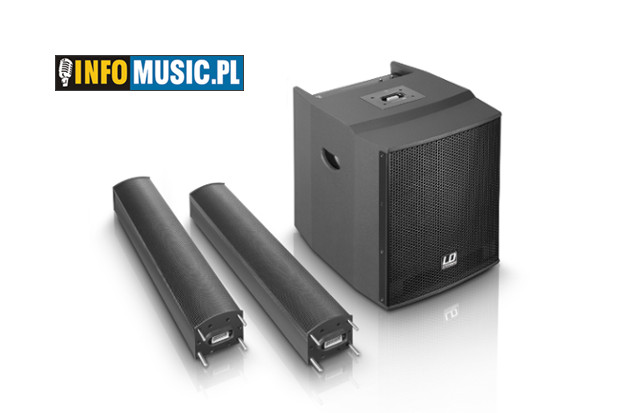
Portable active PA systems have been enjoying increasing popularity in the audio market for some time. There is a clear trend for these compact systems, which benefit from expansive functionality, are easy to use and at the same time allow for sufficient flexibility. We are going to focus on relatively low-cost systems for medium-sized events in particular, which can be operated by a few individuals, or by one person, to do as much as possible and which at the same time are convenient to transport and install.
This post will look at the MAUI Series (Multiple Array User Intuitive) by LD Systems, a series of compact, elegant PA solutions that can be installed in seconds. The black and white standard models MAUI 11 and MAUI 28 belong to the series, as do their accessories. The MAUI 28, which has been available since 2011, is the most popular product in the series. Meanwhile, LD Systems has updated the range with the new MAUI 28 MIX. The MAUI 28 MIX is a compact column PA system that serves as an “all-in-one” solution.
It consists of a subwoofer and two slim satellites with multiple speakers which are plugged together to create a free-standing tower. The new version also features a 3-channel mixer. According to the descriptions, the system is characterised by high mobility, quick installation, high sound and build quality and an elegant, discreet appearance. Let’s see what’s behind it.
Visual inspection, installation and first impressions
Even before the MAUI 28 arrived, I knew a little bit about the presentation and the public feedback system. Still, I was curious to see how it did “up close”. The system, consisting of the subwoofer (390 x 450 x 510 mm), two satellites (90 x 110 x 790 mm) and the power cord is actually quite small once it’s unpacked. “That’s it?” you might ask.
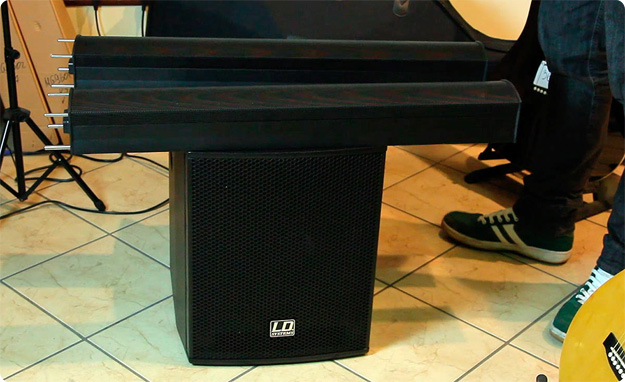
Active PA systems are now available in abundance. Most consist of a subwoofer and individual boxes and usually additionally require music stands, power and audio cables, etc. This contributes to the size and weight, which is at the expense of portability. The MAUI 28 MIX paints a completely different picture, and I must admit that I really like the concept of the column system. The individual components can be installed in less than a minute once they’re unpacked.
All three elements have cotter pins, multi-pin connectors and bolts to stabilise and identify the boxes (the satellites must be assembled in the correct order). The subwoofer has a central plug-in connection on top, to which only the first satellite is connected. The second column is then connected to this connection. All that’s left to do is connect the subwoofer to the socket – that’s it! The system is now ready for use.
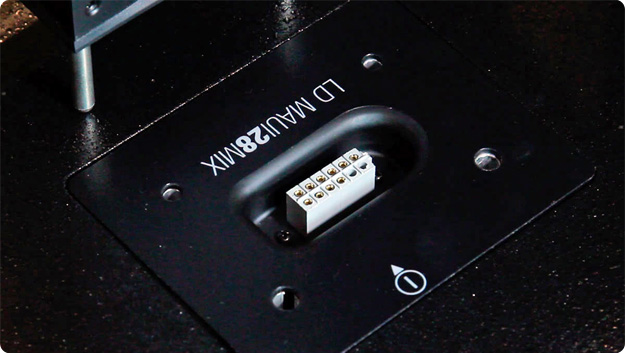
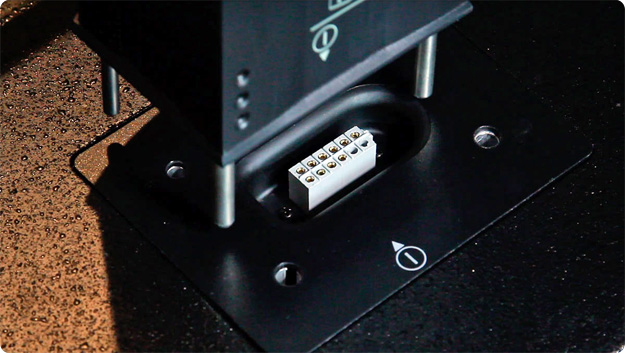
It should be mentioned that the subwoofer is basically just an active speaker. The satellite columns are passive; the power and audio signals are transmitted via the connection terminals. The subwoofer contains all of the amplifier modules, processors, audio ports, and the mixer, practically making it the nerve centre of the whole system. Once the system is built, the elegant system stands two metres tall as a slender, black tower. The compact dimensions and design allow the system to be set up inconspicuously or even integrated in a decorative manner into a room. The structure, including connections and bolts, also holds the elements together so well that, even in its assembled state, the system can be easily moved with the appropriate care, of course.
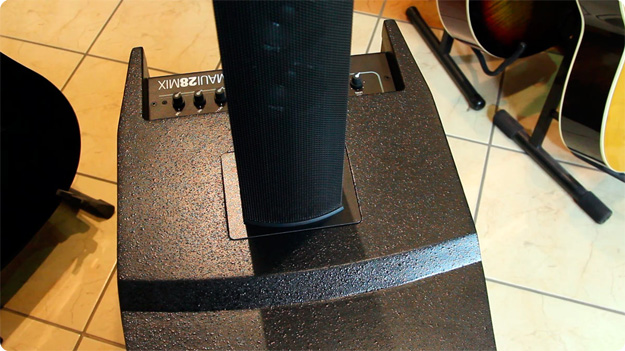
The first visual impression suggests that the system meets its brief of mobility, quick installation time and aesthetic characteristics suited to presentations, lectures, smaller conferences and performances, or even for mobile DJs. In order to confirm this, it is necessary to examine the main features of this audio system in more detail. We were initially interested in the connections, mixer, speakers, and, of course, the performance and sound quality of the PA.
Incoming test: Design, speakers, connectors and power
Construction:
The MAUI 28 MIX consists of a subwoofer and two satellites, which are plugged together to form a column. The system contains a total of 19 available speakers. The subwoofer is made of plywood and a large bass reflex port on the front panel has two 8″ woofers with ferrite magnets. The satellites are composed predominantly of aluminium and have a total of 16 3″ speakers (8 per item) with neodymium magnets, which are vertically superposed and divided into four groups by frequency ranges. The top satellite also has a 1″ tweeter installed on the top. The entire PA system weighs 35.4 kg.
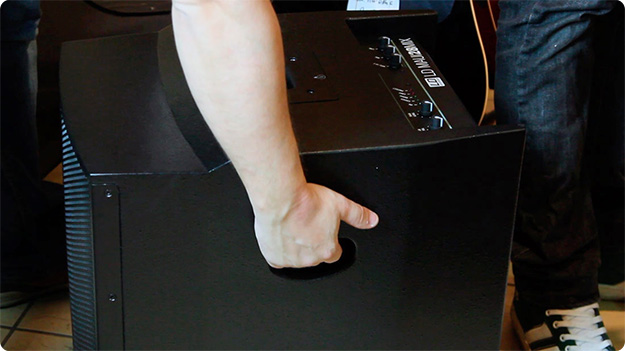
Connections:
As already mentioned, all the connections, amplifiers and other central components are located in the subwoofer. All of the connections are located on the back; the mixer with the frequency controllers and the control display, however, is mounted on the top. The MAUI has numerous connection options, such as the microphone input XLR/6.3mm jack combo; the switchable MP3/HI-Z input (mini and 6.3mm jack) for MP3 players or instruments (e.g. guitars.); the stereo line input (phono and 2 XLR/6.3mm jack combos; and line outputs (2 XLR).
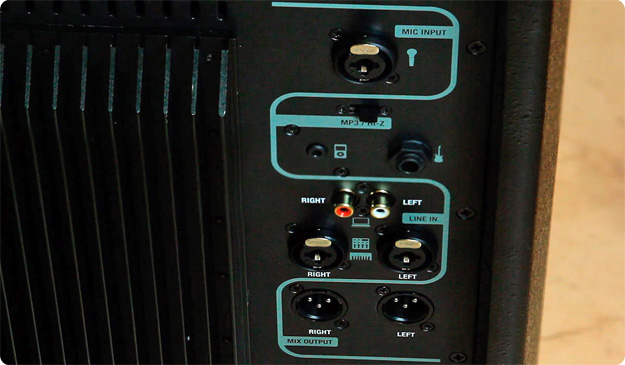
It has all the modern connections you need. (However, a USB port would have been useful.) All three of these groups of these inputs can be used in parallel. So you can connect a microphone, guitar and keyboard or microphone too, an external mixer signal and an MP3 player to the MAUI 28 MIX at the same time. The stereo line output can send the signal to another MAUI 28 system or other speaker in turn.
Mixer:
The individual input signals are controlled via the built-in mixer. The term “mixer” is, in all honestly, a bit of an overstatement here. There are just three volume controls for the respective signals Mic, Line and HI-Z/MP3. The overall controller (Main Level) is located next to this, as is the Sub Level for the subwoofer’s volume.
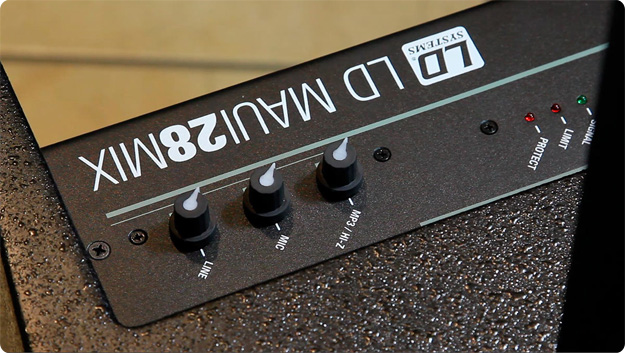
It doesn’t have any further settings options. The PA is limited, but in most cases it is sufficient. What I mean is that more progress could have been made on this new and revised version of the MAUI 28, such as considering a graphic equalizer or simple compressor with a single controller. The system features a dual limiter as well as LED displays for ON (Power), LOCKED (illuminated upon correct connection of all system components, otherwise the system is inactive), SIGNAL (shows present signal) and the two red LIMIT LEDs (limiter), and finally PROTECT (protection circuit).
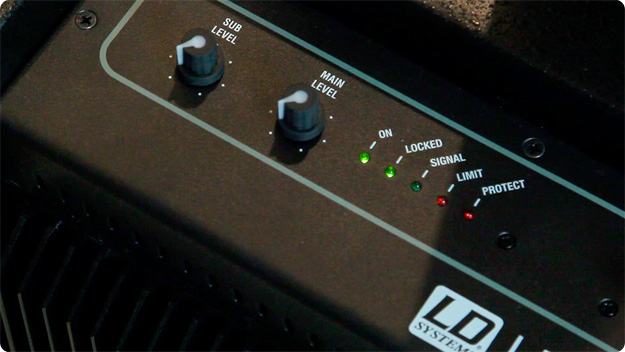
Amplifiers and crossovers:
The subwoofer contains the amplifier for the whole system and a digital crossover. The crossover divides the signal in five frequency bands and sends them to the following five groups of speakers: two 8″ speakers in the subwoofer for the frequencies 45-170 Hz, 4 x 3″ speakers for 170-600 Hz, 4 x 3″ speaker for 170-900 Hz, 4 x 3 ” speakers for 170-1300 Hz, 4 x 3″ speakers for 500-20,000 Hz and a 1″ tweeter for 8000-20,000 Hz (with its own passive crossover).
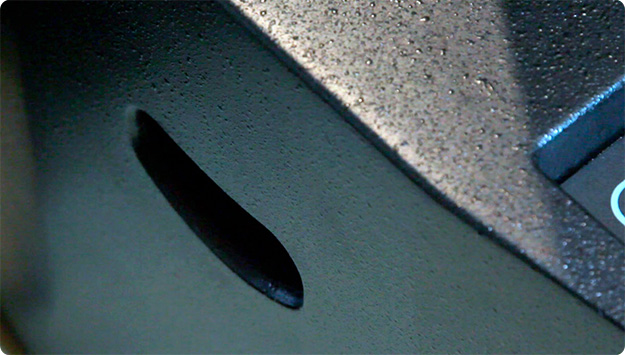
The amplifier is a five-way Class A/B system with a total of 400 W (RMS). The subwoofer amplifier is 200 W, the remaining four modules for the individual speaker groups are 50 W each. The horizontal dispersion of the entire PA is 120°.
Up Close and Personal: Sound Quality Evaluation
Now we want to finally take a good listen to the MAUI 28 MIX. In order to test the sound quality comprehensively, I used all of the signal sources that you can use to control the system, such as a microphone, a line instrument (in this case a guitar and bass), an MP3 player and a line signal from an external mixer (recording of a band).
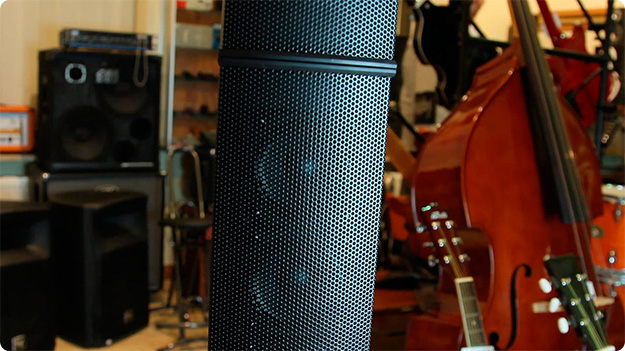
The first test took place in a smaller space (music shop) with a microphone, acoustic guitar and lastly with canned music. Of course, it took a little while to get the system set up and properly adjusted. However, the soundcheck wasn’t great: The voice was quite flat, pretty mediocre, and it didn’t have any depth. The same picture emerged with the guitar, which seemed quite hollow, mid-heavy and without depth and transparency in the highs. Not even the recorded music could convince us with its unspectacular, flat playback.
After these unexpected results I took the PA to a roomy apartment. The conditions were somewhat different here, because there was more space and the rooms generally had slightly better acoustics. I connected my laptop via the phono input to the MAUI and played some music of my own choice (I opted for the new record by Pelican, the White Album by Baroness and Shellac). The result didn’t blow me away this time either. I could certainly appreciate the music, but it was lacking in depth and pressure.
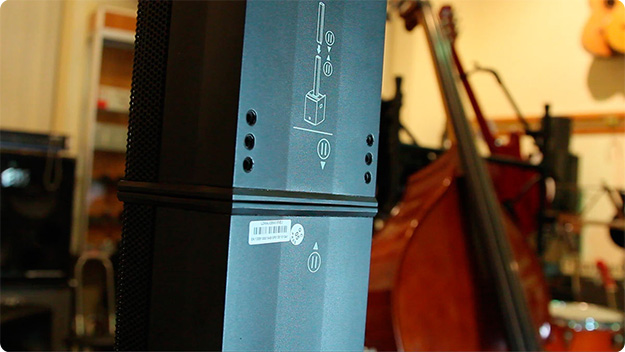
I finally decided to do a little experimenting with the positioning of the system. I placed the equipment in the extreme corner of the largest room and moved myself in the other direction. The repositioning already started to make a difference. The sound was not as mid-heavy and gradually became rounder and fuller. The playback music still didn’t sound great, and no better than on average monitors, but still satisfactory. The same can be said of the other signal sources.
The manual states that a minimum distance of three metres between the audience and speakers is recommended, and in fact the sound coming from the PA from a shorter distance sounds unnatural. This is certainly due to the fact that the speakers are mounted vertically in the almost two-metre-high tower and each transmit separate frequencies. If you stand too close to the satellites, the frequencies of the nearest loudspeaker dominate. At a greater distance, the sound is more uniform.
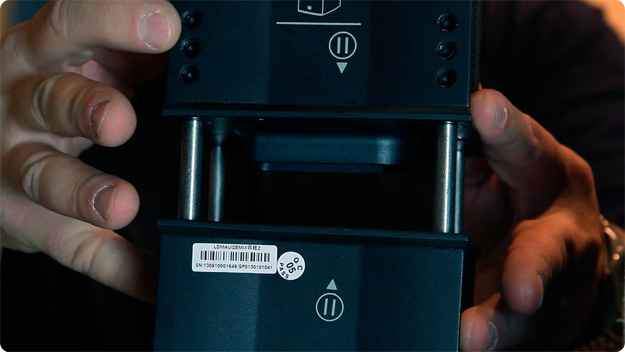
This is certainly due to the wide beam angle of 120 °. This relatively high value certainly pays off. A single MAUI 28 MIX column has what it takes to be really efficient over a wider space. Up close, the system again sounds significantly better if it is placed at an oblique angle rather than head-on. The sound signals from an external mixer were also significantly improved, after I had corrected the position of the MAUI column. I could use the mixer or its equalizer to take countermeasures, which would make a big difference. Such sound adjustments are generally highly recommended for working with the MAUI. If the system is well positioned, the sound by itself will be good, but not outstanding. An external equalizer could support the final sound in a positive manner in this regard.
A few words on the functionality – Summary
Following all of this information, we are now going to take a closer look at the functionality of the MAUI 28 MIX. There is no doubt the system scores highly on its design principle. Due to the easy transport and the lightning-fast assembly, it is ideal for smaller events or even for solo entertainers. The MAUI 28 MIX was clearly designed to be a very flexible and adaptable device. It has many different connections and a mini-mixer, allowing the signals from three different sources can be transmitted simultaneously. Thanks to its elegant appearance, the system certainly fits in well everywhere in terms of aesthetics, or when the PA should be invisible (e.g. presentations and lectures in the culture, education and economy sectors).
Its simple construction and the extremely limited control panel would even allow someone without any experience with professional PA systems to operate the device. Also, the size and weight mean that one person can handle the transport and assembly without a problem. The sound is not crystal clear and deep, but when suitably positioned, it is perfectly adequate for most situations. The wide dispersion angle also facilitates use in larger spaces. An additional equalizer would improve the result, but would also be a cost factor. Since the system has good feedback suppression and a few power features, it can also be used without additional supportive monitors.
The volume is sufficient as a “soloist” at smaller events. Because of these special features, it would do especially well in pubs or bars, which are suited to smaller music or vocal performances, readings, comedy, etc. It could also be used by a mobile DJ for smaller parties or in churches. In addition, the PA cuts a good figure at any kind of business or cultural event. And if worst comes to worst, you could always amplify a smaller band using an additional external mixer. The combination of decent sound quality and unique mobility makes all this possible. The product will certainly not satisfy everyone and the truth is that it is far from perfect. Especially since the original price of more than 4000 zloty is not very cheap.
It’s worth trying out the PA and giving it a chance though, because it certainly is potentially suitable for many situations in the audio sector.
Overall rating:
![]()
Specifications:
– Active column PA system
– Frequency response: 45-20,000 Hz
– Weight: 35.4 kg – Max. continuous sound pressure:. 115 dB
– Max SPL. (peak): 123 dB
– Housing material: Subwoofer – plywood, satellites – aluminium.
– Loudspeakers: 2 x 8″ (ferrite), 16 x 3″ (neodymium), 1 x 1″ (ferrite)
– RMS performance: 400 W
– Amplifier: 5-way Class A/B
– Protection circuit: Dual limiter
– Cooling: Aluminium heatsink
– Operating voltage: 220 V AC – 240 V AC, 50-60 Hz
Pro’s
+ Very easy to use, quick installation
+ compact size and lightweight, easy to transport
+ lots of connection possibilities, versatility, multiple backups
+ wide beam
Con’s
– sound quality leaves something to be desired
– no EQ graphics or simple compressor
– not cheap
– USB input would be beneficial
____________________________________________
Source:: infomusic.de, Januar 2014: http://www.infomusic.pl/naglosnienie/test/39615,ld-systems-maui-28-mix-test-aktywnych-kolumn-naglasniajacych
Author: Maciej Żulczyk
Click here for more information about LD Systems Maui 28 Mix:
http://www.ld-systems.com/en/complete-pa-systems/maui-28-mix-compact-column-pa-system-active-with-integrated-3-channel-mixer/
Leave a Comment
You must be logged in to post a comment.












